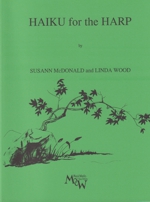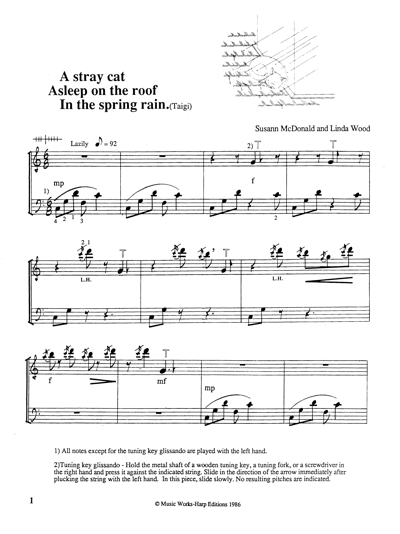 |
Haiku for the Harp Susann McDonald & Linda Wood Rollo |
||
| Contents: | 12 harp solos (see contents) | ||
| Instrumentation: | Pedal Harp (most adaptable for Lever Harp) | ||
| Level: | Intermediate / Advanced | ||
| Format: | US letter stapled score | ||
| ISMN: | -- | ||
| Publisher: | MusicWorks - Harp Editions | ||
| Edition/Year: | 1986 | ||
| Origin: | USA | ||
| Our Ref: | UM1269 | ||
Buy this music now £18.00 +p&p |
|||
| Other works from Susann McDonald & Linda Wood Rollo | |||
Haiku for the Harp
Susann McDonald & Linda Wood Rollo
Introduction
Haiku is Japanese poetry that points to small moments in nature which were meaningful to the poet. Each poem contains seventeen (5-7-5) fixed syllables and a reference to the seasons of the year.
In this collection, twelve Haiku have been used as settings for the short studies and pieces. The music is designed to provide training in some of the techniques commonly used by 20th century composers such as complex rhythms, changing meters, extra-digital techniques, the use of accessories, and improvisation. It is hoped that the comfortable acquaintance with these skills will encourage young harpists to perform new music and to enjoy it.
Because of the very few pedal changes, most of the pieces are adaptable to the Troubadour harp. Pedal diagrams are shown which remain in effect for each piece. Accidentals are not indicated after the first measure except in conjunction with the few pedal changes which are clearly indicated. In most of these pieces, non-traditional key signatures are used. The top and bottom notes of all glissandi are approximate and not intended to be plucked separately.
A glossary of symbols used and how they are to be executed appears in the back of the book. Instructions also appear in each piece for quick and specific reference.
Illustrated by Wanda Baden
Foreword
Composers of the past 40 years have been busily and significantly adding to the repertoire of all instruments. Hard to escape, though, is the fact that the great bulk of solo and chamber works produced during this time calls for performers of virtuoso skills and experience. The lack of high-quality contemporary music for young and intermediate level players is especially evident at the college level where one encounters large numbers of students who have had no in-depth exposure to new music anywhere in their training. How, then, to take young but eager and able students and introduce them with a sense of discovery and accomplishment to the music of their own time?
The collection you hold in your hands is one response, and a highly successful one, to this problem as it applies to the harp. Professors McDonald and Wood have composed elegant, poetic pieces that introduce new techniques and concepts gradually and progressively. The result is music that is both within reach of younger musicians and fun to play, with the not incidental benefit of laying the groundwork for "graduation" to some of the virtuoso literature that lies beyond. While Parnassus is not to be scaled in one leap, it is most comfortably approached through its foothills. These are most admirable (and useful) foothills! In closing, I can only hope that other master performers and teachers will emulate the present authors in providing younger students of their instruments with equally stimulating keys to the riches of today's music.
Harvey Sollberger, Professor of Music
Director, New Music Ensemble Indiana University, Bloomington
Contents
A stray cat Asleep on the roof In the spring rain
Techniques: Tuning key glissandi
Tools needed: Wooden tuning key with metal shaft, tuning fork or screwdriver
A flash of lightning! The sound of dew Dripping down the bamboo
Techniques: Pedal buzz, fingernail glisses, whistle
Tools needed: Rubber tuning key
Sacred music at night; Into the bonfires Flutter the tinted leaves
Techniques: Tremolos between strings, paper in strings
Tools needed: Two pencils, notebook paper
Being chased, The firefly Hides in the moon
Techniques: Introduction to bisbigliando
Sweeping the garden, The snow is forgotten By the broom
Techniques: Rhythms, changing meters
Tools needed: Two paintbrushes (brushes must be 3-4 inches wide)
Striking the fly, I hit also A flowering plant
Techniques: Fingernail scrapes and flicks, rubbing string, percussive sounds, rapid muffles, extra-musical activities
The sparrows Are playing hide and seek Among the tea flowers
Techniques: Non-traditional notation, improvisation, optional sequence,
tuning key buzzes, percussive sounds
Tools needed: Tuning key
The old pond; A frog jumps in, The sound of water
Techniques: Xylophonic sounds
After the moon-viewing, My shadow walking home Along with me
Techniques: Traditional harmonics and harmonics of the 12th
Even among insects, in this world, Some are good at singing, Some bad
Techniques: Pres des chevilles, xylophonic sounds, extra-digital sounds,
rub string, non-traditional notation.
Tools needed: Metal rod (or wooden tuning key)
Dance from one blade of grass To another, Pearls of dew
Techniques: Traditional notation, meter changes, pentatonic
Distant lights; There they live This autumn night
Techniques: Changing meters, repetition, expressivity
